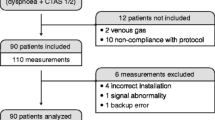Abstract
Transcutaneus PO2 (PtcO2) is suggested to reflect tissue oxygenation in intensive care patients, whereas transcutaneous PCO2 (PtcCO2) is advocated as a noninvasive method for assessing PaCO2. In 24 critically ill adult patients (mean Apache II score 14.2, SD 4.7) we investigated the impact of variables that are commonly thought to determine PtcO2 and PtcCO2 measurements. A linear correlation was found between PtcO2 and PaO2 (r=0.6;p≤0.0001) and between PtcO2 and mean arterial blood pressure (MAP;r=0.42;p≤0.003). Cardiac index (CI) correlated with tc-index (PtcO2/PaO2;r=0.31;p≤0.03). There was no relationship between PtcO2 and hemoglobin concentration (Hb) and the position of the oxygen dissociation curve (ODC). Stepwise multiple regression analysis demonstrated a significant influence of PaO2 and MAP on PtcO2. The contribution of CI, Hb and the ODC was not significant. Only 40% of the variability of a single PtcO2 measurement could be explained by PaO2 and MAP. A significant linear correlation was demonstrated between PtcCO2 and PaCO2 (r=0.76;p≤0.0001) but not between PtcCO2 and CI, MAP and arterial base excess (BEa). Stepwise multiple regression analysis revealed an influence of PaCO2 and of CI on PtcCO2; 66% of the variability of a single PtcCO2-value could be explained by PaCO2 and CI. Our data demonstrate that transcutaneous derived gas tensions result from complex interaction between hemodynamic, respiratory and local factors, which can hardly be defined in ICU-patients.
Similar content being viewed by others
References
Tremper KK, Shoemaker WC (1981) Transcutaneous oxygen monitoring of critically ill adults, with and without low flow shock. Crit Care Med 9:706–709
Tremper KK, Waxman K, Shoemaker WC (1981) Use of transcutaneous oxygen sensors to titrate PEEP. Ann Surg 193:206–209
Tremper KK, Barker SJ (1987) Transcutaneous oxygen measurement: experimental studies and adult applications. Int Anesthesiol Clin 25:67–96
Reed RL, Maier RV, Landicho D, Kenny MA, Carrico CJ (1985) Correlation of hemodynamic variables with transcutaneous PO2 measurements in critically ill adult patients. J Trauma 25:1045–1053
Tremper KK, Waxman K, Bowman R, Shoernaker WC (1989) Continuous transcutaneous oxygen monitoring during respiratory failure, cardiac decompensation, cardiac arrest and CPR. Crit Care Med 8:377–381
McEverdy BAB, McLeod ME, Mulera M, Kirpalani H, Lerman J (1988) End-tidal, transcutaneous, and arterial PCO2 in critically ill neonates: a comparative study. Anesthesiology 69:112–116
Phan CQ, Tremper KK, Lee SE, Barker SJ (1987) Noninvasive monitoring of carbone dioxide: a comparison of the partial pressure of transcutaneous and end-tidal carbone dioxide with the partial pressure of arterial carbone dioxide. J Clin Monit 3:149–154
Haisjackl M, Hasibeder W, Sparr H, Klaunzer S, Putz G, Kroesen G (1989) Die Verwendung einer transkutanen PO2/PCO2-Kombielektrode während der Volumentherapie bei einem schockierten Kleinkind. Anaesthesist 38:431–433
Bhat R, Kim WD, Shukla A, Vidyasagar D (1981) Simultaneous tissue pH and transcutaneous carbone dioxide monitoring in critically ill neonates. Crit Care Med 9:744–749
Ewald U, Tuvemo T, Rooth G (1985) Detection of exercise-induced lactic acidosis using transcutaneous carbone dioxide. Crit Care Med 13:630–632
Knaus WA, Draper EA, Wagner DP, Zimmerman JE (1985) Apache II: a severity of disease classification system. Crit Care Med 13:818–823
Severinghaus JW, Stafford M, Thunstrom AM (1978) Estimation of skin metabolism and blood flow with PtcO2 and PtcCO2 electrodes by cuff occlusion of the circulation. Acta Anaest Scand 69:9–15
Severinghaus JW (1979) Simple, accurate equations for human blood O2 dissociation computations. J Appl Physiol 46:599–602
Armitage P, Berry G (1987) Statistical methods in medical research. Blackwell Scientific Publication, Oxford London Edinburgh Boston Paolo Alto Melbourne
Abraham E, Smith M, Silver L (1984) Conjunctival and transcutaneous oxygen monitoring during cardiac arrest and cardiopulmonary resuscitation. Crit Care Med 12:419–421
Tremper KK, Waxman K, Shoemaker WC (1979) Effects of hypoxia and shock on transcutaneous PO2 values in dogs. Crit Care Med 7:526–531
Vincent JL, Moraine JJ, Van der Linden P (1988) Toe temperature versus transcutaneous oxygen tension monitoring during acute circulatory failure. Intensive Care Med 14:64–68
Lübbers DW (1981) Theoretical basis of the transcutaneous blood gas measurements. Crit Care Med 9:721–726
Mirhashemi S, Breit GA, Chavez RH, Intaglietta M (1988) Effects of hemodilution on skin microcirculation. Am J Physiol 254:H411-H416
Bredle DL, Samsel RW, Schumacker PT, Cain SM (1989) Critical O2 delivery to skeletal muscle at high and low PO2 in endotoxemic dogs. J Appl Physiol 66:2553–2558
Hurd TC, Dasmahapatra KS, Rush BF, Machiedo GW (1988) Red blood cell deformability in human and experimental sepsis. Arch Surg 123:217–220
Haisjackl M, Hasibeder W, Klaunzer S, Altenberger H, Koller W (1990) Diminished reactive hyperemia in the skin of critically ill patients. Crit Care Med 18:813–818
Jaszczak P, Poulsen J (1981) Capillary blood temperature in transcutaneous PO2 measurement. Acta Anesthesiol Scand 25:487–491
Tremper KK, Shoemaker WC, Shippy CR, Nolan LS (1981) Transcutaneous PCO2 monitoring on adult patients in the ICU and the operating room. Crit Care Med 9:752–755
Author information
Authors and Affiliations
Rights and permissions
About this article
Cite this article
Hasibeder, W., Haisjackl, M., Sparr, H. et al. Factors influencing transcutaneous oxygen and carbon dioxide measurements in adult intensive care patients. Intensive Care Med 17, 272–275 (1991). https://doi.org/10.1007/BF01713936
Received:
Accepted:
Issue Date:
DOI: https://doi.org/10.1007/BF01713936




